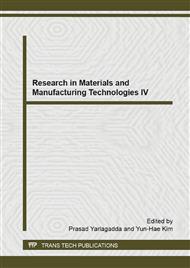[1]
G Y Tian,J Wilson,L Cheng,et al. Pulsed eddy current thermography and applications[M]. New Developments in Sensing Technology for Structural Health Monitoring Lecture Notes in Electrical Engineering, 2011, 96: 205-231.
DOI: 10.1007/978-3-642-21099-0_10
Google Scholar
[2]
G Zenziger,J Bamberg,et al. Thermographic crack detection by eddy current excitation[J]. Nondestructive Testing and Evaluation, 2007, 22(2-3): 101-111.
DOI: 10.1080/10589750701447920
Google Scholar
[3]
Ilham Zainal Abidin, Gui Yun Tian, John Wilson, Suixian Yang, Darryl Almond. Quantitative evaluation of angular defects by pulsed eddy current thermography[J]. NDT&E International, 2010, 43: 537-546.
DOI: 10.1016/j.ndteint.2010.05.010
Google Scholar
[4]
N. Tsopelas, N J Siakavellas. The effect of the angle of inclination of the exciting coil in electromagnetic-thermal non-destructive inspection[C] In: 4th International conference on NDT, 11-14 Oct 2007, Chania, Crete-Greece.
DOI: 10.1504/ijmpt.2011.040294
Google Scholar
[5]
Suixian Yang, Gui Yun Tian, Ilham Zainal Abidin, John Wilson. Simulation of edge cracks using pulsed eddy current stimulated thermography[J]. Journal of Dynamic Systems, Measurement and Control, 2011, 133.
DOI: 10.1115/1.4002710
Google Scholar
[6]
John Wilson, Gui Yun Tian, Ilham Zainal Abidin, Suixian Yang and Darry Almond. Modeling and evaluation of eddy current stimulated thermography[J]. Nondestructive Testing and Evaluation, 2010, 25: 205-218.
DOI: 10.1080/10589750903242533
Google Scholar
[7]
N. Biju, N. Ganesan C.V. Krishnamurthy, Krishnan Balasubramaniam. Frequency optimization for eddy current thermography[J]. NDT&E International, 2009(42): 415-420.
DOI: 10.1016/j.ndteint.2009.01.011
Google Scholar
[8]
Ben Weeks, Darryl P Almond, Peter Cawley, Tim Barden. Eddy-current induced thermography-probability of detection study of small fatigue cracks in steel, titanium and nickel-based super alloy[J]. NDT&E International, 2012, 49: 47-56.
DOI: 10.1016/j.ndteint.2012.03.009
Google Scholar
[9]
Liu Huilong, Liu Zhiping, Cheng Yifan, Tang Fanfang. Simulation of Infrared Thermal-wave Test on Weld Surface Crack of Crane Metal Structure[J]. Journal of Wuhan University of Technology(Transportation Science & Engineering), 2014, 38(1): 153-154.
Google Scholar


